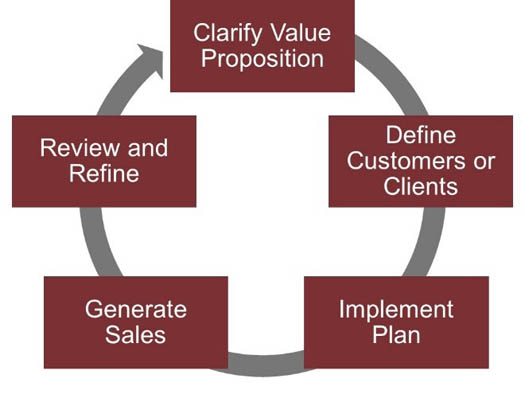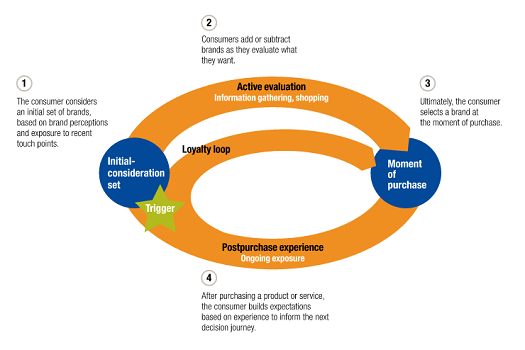The Marketing Cycle: An Overview
Marketing is often thought of as a static, one way attempt to increase sales. Super bowl commercials, highway billboards, and internet content point to this notion. However, these communication methods are almost always part of a more complex plan. Companies spend millions of dollars critiquing a specific message for a specific audience. They deploy the campaign with great intentionality and track metrics for a set period of time. The campaign produces new leads, which are intended to close sales. After finishing the marketing campaign the team and management review the results in order to prepare for the next marketing cycle.

The process described above is known as the marketing cycle. This is not to be confused with market cycles, which denote boom and bust cycles of specific industries. Rather, this cycle is one that every business must operate in to drive sales, intentionally or un-intentionally. It is important to highlight the use of the word “cycle,” because, like other cycles, the process is reoccurring.
Specifically, the phases in the marketing cycle are:
- Clarify the value proposition
- Define customers or clients
- Implement the plan
- Generate Sales
- Review and refine
The Giersch Group provides marketing consulting for small and mid-sized businesses in the greater Milwaukee & Madison areas.
Get a free consultation to learn more about our flexible services and affordable rates.
Phase 1: Clarify Value Proposition
Value is a vital word that has multiple meanings. Within the context of marketing, a value proposition is simply defined as a business’s unique selling proposition—or, what makes one different in the market. Coca Cola’s unique value or selling proposition is their exceptional Coca Cola formula and their vast distribution network. Many beverage companies have exceptional drinks, but Coke products are loved around the world, even in remote places.
One method of understanding or defining your value proposition is to listen to current customers or clients. What are the reasons they purchase from you? Typically, business owners ask this question on an ongoing basis in order to shape their value proposition, but some require a formal approach to gathering information, such as a survey. A customer survey is a litmus test to understand the current perceptions of your customer base.
Phase 2: Define Customers or Clients
A current customer validates your value proposition, as they have paid for products or services and represent revenue. It is important to understand various customer profiles. A customer profile, also known as a buyer’s persona, articulates the level of need, capacity and willingness to pay, sales cycle, capacity to buy additional products, and capacity to refer other customers. Additionally, the customer profile can categorize demographic and psychographic attributes. There will be multiple customer profiles and these will dictate the specific marketing strategy.
One curious issue is management’s perception of customers. Management could have a distorted perception of the actual customer vs. the target customer. These perceptions surface when business owners define their ideal customer in a way that has little in common with their current customer base. Usually, the company will not be able to reach this aspirational customer without some significant change to their business model or infrastructure. When the ideal customer profile contrasts with the current customer profile in this way, marketing efforts usually result in a substantial loss of funds, time and profits. Honestly assessing current customers and future target markets are essential to the success of the marketing campaign.
Phase 3: Implementing the Plan
The first two phases of the marketing cycle offer a foundation, where a business can understand its message and the recipient of the message by correctly articulating its value proposition and current customer base. The next step is to deliver the message effectively. This is the third phase of the marketing cycle: implementing the marketing plan.
With the emergence of web and mobile marketing there are many “shiny objects” to chase after for the promise of more revenue. In the small enterprise space, we find that here is still a tremendous amount of value in the more traditional methods, such as networking, speaking events, direct marketing, public relations and referrals. It is tempting to look at traditional marketing as dated or obsolete, but they have been and continue to be used because they have been known to work. It is easy to forget this fact when one is being sold the wonders of SEO and social media as if they are the solution to all of your revenue needs. The old sayings about “too good to be true” often apply. No one form of marketing is the Silver Bullet and any good marketing plan has many methods working together. Other pieces such as personnel, adequate budget, a timeline, and short and long term goals are also key to success. These pieces frame the marketing plan, so that it is ready to launch in a systematic manner. It is important to note that short term goals are defined by Key Performance Indicators (KPI’s) or known as sales metrics, where long term goals are defined, most traditionally, as revenue targets.
Phase 4: Generate Sales
Marketing, in a general sense, could produce many outcomes, such as increased engagement, brand awareness, or simply support for the sales team, but the main purpose of marketing is to drive revenue. Phase four of the marketing cycle is the opportunity to convert leads generated in phase 3 into loyal customers or clients.
Similar to a marketing plan, sales has many steps and many tools. These tools include cloud based customer relationship management (CRM) software and an automated sales pipeline to ensure correct communication with leads. However, these tools do not change the process or the relationship of sales to marketing. Traditionally sales has been thought of as a funnel but the emergence of consumer education and the interaction of consumers on social media has modified this traditional funnel. McKinsey & Company outline the sales process as a Consumer Decision Journey.[1] This journey is marked by greater consumer awareness and education, as well as a post-purchase experience.
Phase 5: Review and Refine
Owners and management, alike, often fall prey to the notion that a closed sale is the end of the cycle, but the final phase of the marketing cycle is reviewing and refining all four phases. The review process includes review of the marketing plan and the foundation with which the plan was built. Best practices show that a formal annual review coupled with reviews after each marketing campaign ensure the ability to pivot and marketing momentum. Additionally, it gives an opportunity to regularly review short term and long term goals. The review process must be honest and clearly focused on continuous improvement so that refinement can add value.
Conclusion
The marketing cycle is one cycle that each business must employ to craft a specific message and distribute it to the correct audience in order to drive sales. Other marketing cycles have more steps or less phases depending on the level of depth. The Giersch Group has found this level of simplicity to work well for small enterprises. Finally, marketing efforts are most successful with much diligence and discipline.
More free marketing cycle resources
[1] Adapted from Mckinsey & Company.
Get a free consultation to learn more about our services and how marketing consulting can grow your business.
The Giersch Group has offices in Milwaukee, Brookfield and Madison, Wisconsin.
